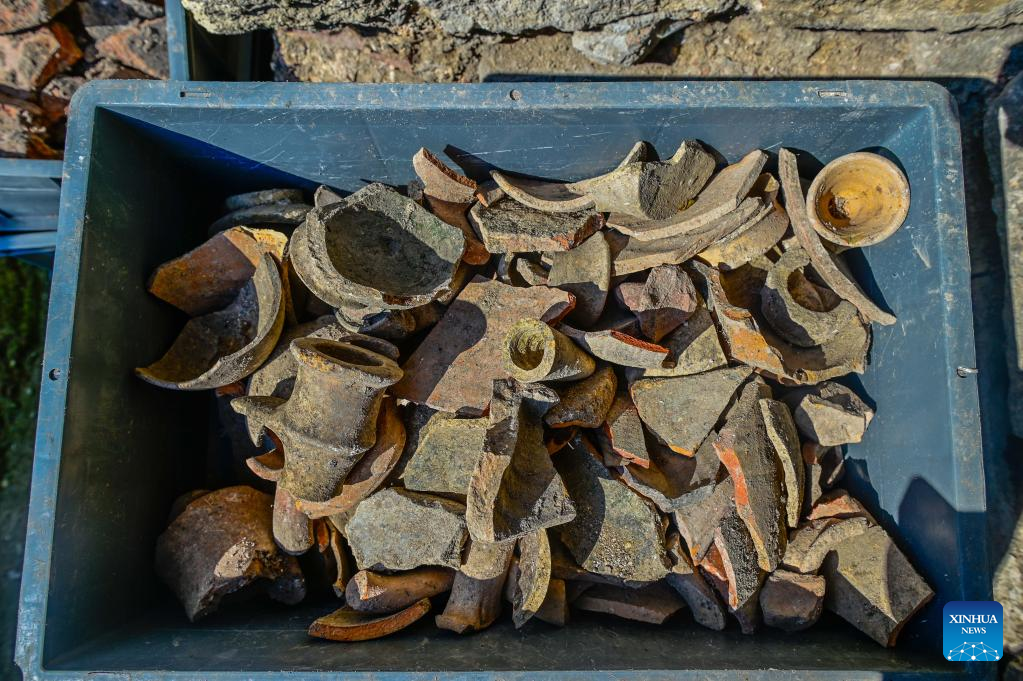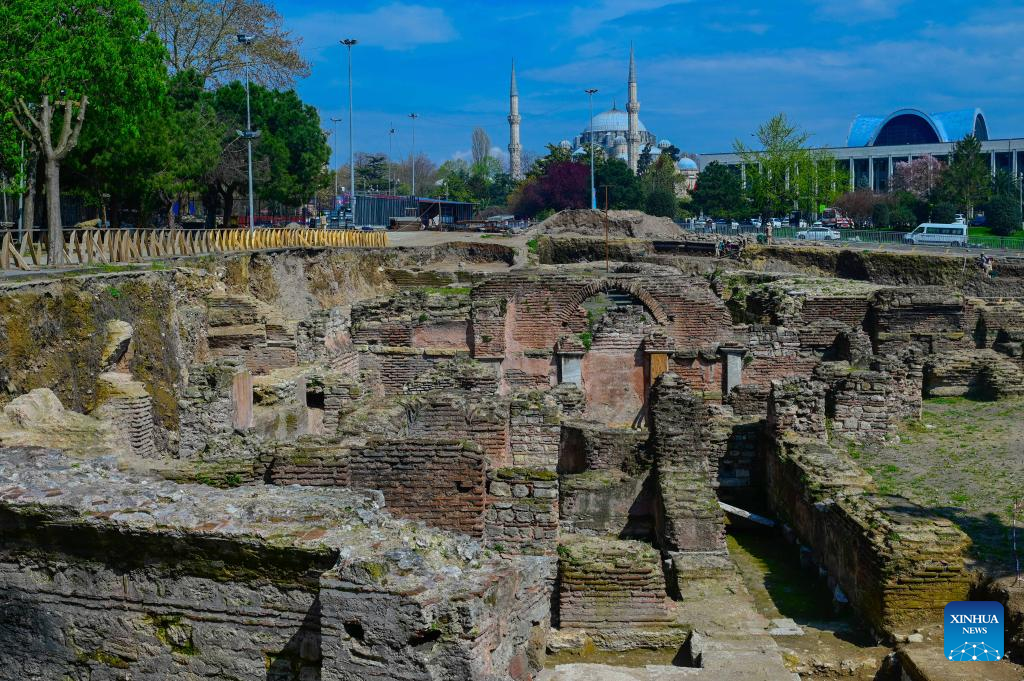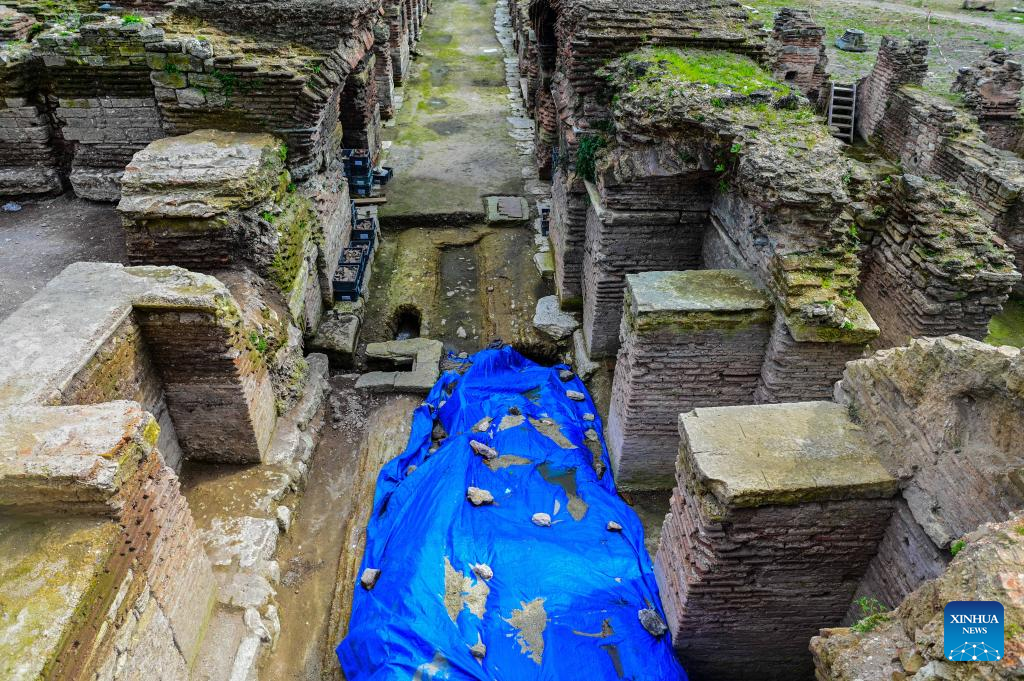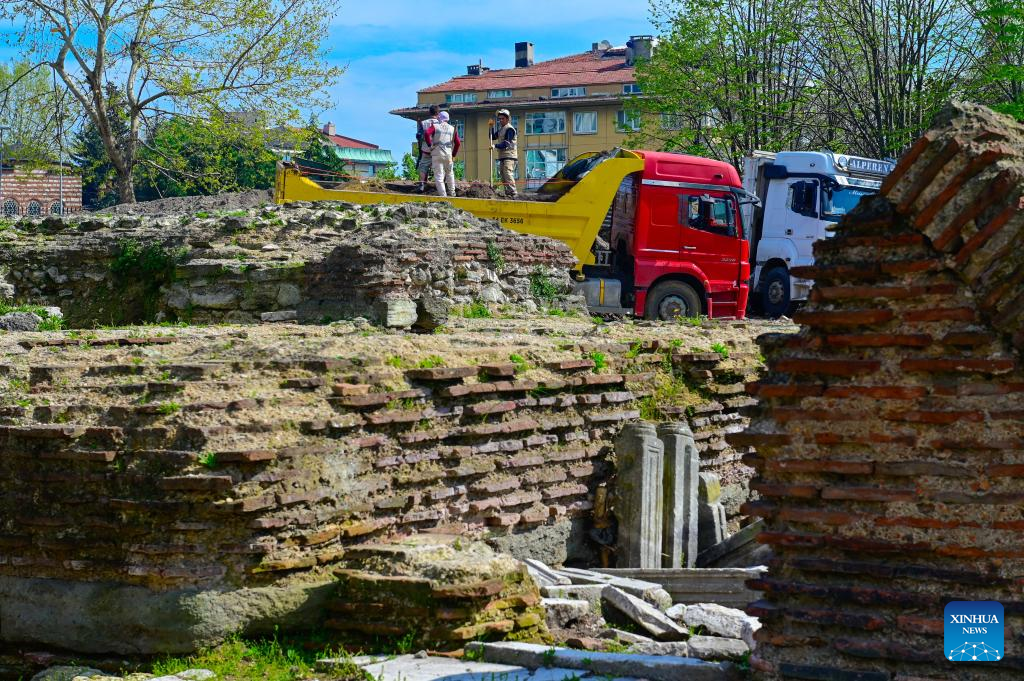
This photo taken on April 19, 2023 shows the excavated parts of the Church of St. Polyeuctus in the Sarachane Archaeological Park in Istanbul, Türkiye. Located in Istanbul's historic quarter, the remains of a Byzantine church sit in a lot where residents dumped their trash and homeless people slept until recently. But now, a new archaeology park is being built with the goal of reinvigorating the Church of St. Polyeuctus, which had vanished beneath urban sprawl nearly a millennium ago.(Photo by Omer Kuscu/Xinhua)
ISTANBUL, April 25 (Xinhua) -- Located in Istanbul's historic quarter, the remains of a Byzantine church sit in a lot where residents dumped their trash and homeless people slept until recently. But now, a new archaeology park is being built with the goal of reinvigorating the Church of St. Polyeuctus, which had vanished beneath urban sprawl nearly a millennium ago.
"It had become a dump," Merve Gedik, project director at Istanbul Municipality's Cultural Heritage Department, told Xinhua, referring to the condition of the church in the Sarachane neighborhood of the Fatih district. "We kept cleaning it, but it kept reverting to a dump because the people were not aware of what it was."
The remains of the church were initially discovered during the construction of an underpass in the 1960s. From 1964 to 1968, an international team of archaeologists excavated the site. Then, the city forgot about it. In June last year, the municipality began excavating the site once again, and this time with a plan to give it a new life.
"We used to think we can preserve a place by fencing it off, denying people's entry," says Gedik, "but it is not like that until people start using a place and they start protecting it. When they enter it, they understand what it is, and when they visit it, it becomes a part of their everyday life."
And thus, the Sarachane Archaeological Park was born.
"Our goal here is to show that urban archaeology, and even the excavation itself, can be visited," she added, "and to cultivate in both visitors and residents a sense of the city's archaeology, a sense of the city's richness, and to create new points of interest in the city."
Many ancient landmarks often disappeared as the urban landscape grew. The history of St. Polyeuctus is an excellent example of a once-grand building that was lost to time. Constructed between 524-527 A.D. to house the skull of early Christian martyr Saint Polyeuctus, its reign as the largest church in Istanbul was short-lived, overtaken by the reconstruction of the Hagia Sophia in 537 A.D.
The church remained important until the late 11th century when it was ultimately abandoned, its many treasures stripped and used in other structures around the city. The final nail on the coffin came in 1204 with the Latin conquest of the town, when its last remaining artifacts were pillaged and taken to Venice and Barcelona.
"The worst thing that can happen to a building is it being abandoned," says Gedik, "As it disappears from daily life, the decay advances, and the destruction continues. That's why we haven't been able to uncover all sections (of the church), unfortunately. Just being able to unearth the outer walls enough to reveal the basilica's structural plan is fortunate as it is."
One recent discovery at the site was the remains of a cloister in early April, which formerly housed mosaics and mounted gemstones. "We know the church used to be very ornate," she pointed out, "A Sassanid (Persian) decorative style was popular at the time."
The final preparations for the archaeology park are underway. The excavation house has been revamped into a place where people can enjoy beverages while perusing archaeological documents, books, and other resources. A laboratory space where conservation work will take place is almost ready, and soon signs directing people will go up.
While people can make an appointment for a tour of the church now, the park is expected to be fully open to the public in June. And St. Polyeuctus will soon be able to rejoin its old city. ■

This photo taken on April 19, 2023 shows the remains found at the excavation site of the Church of St. Polyeuctus in the Sarachane Archaeological Park in Istanbul, Türkiye. Located in Istanbul's historic quarter, the remains of a Byzantine church sit in a lot where residents dumped their trash and homeless people slept until recently. But now, a new archaeology park is being built with the goal of reinvigorating the Church of St. Polyeuctus, which had vanished beneath urban sprawl nearly a millennium ago.(Photo by Omer Kuscu/Xinhua)

This photo taken on April 19, 2023 shows the remains of the Church of St. Polyeuctus in the Sarachane Archaeological Park in Istanbul, Türkiye. Located in Istanbul's historic quarter, the remains of a Byzantine church sit in a lot where residents dumped their trash and homeless people slept until recently. But now, a new archaeology park is being built with the goal of reinvigorating the Church of St. Polyeuctus, which had vanished beneath urban sprawl nearly a millennium ago. (Photo by Omer Kuscu/Xinhua)

This photo taken on April 19, 2023 shows the remains of the Church of St. Polyeuctus in the Sarachane Archaeological Park in Istanbul, Türkiye. Located in Istanbul's historic quarter, the remains of a Byzantine church sit in a lot where residents dumped their trash and homeless people slept until recently. But now, a new archaeology park is being built with the goal of reinvigorating the Church of St. Polyeuctus, which had vanished beneath urban sprawl nearly a millennium ago.(Photo by Omer Kuscu/Xinhua)

This photo taken on April 19, 2023 shows the remains of the Church of St. Polyeuctus against the backdrop of the urban landscape of the Sarachane neighborhood in Istanbul, Türkiye. Located in Istanbul's historic quarter, the remains of a Byzantine church sit in a lot where residents dumped their trash and homeless people slept until recently. But now, a new archaeology park is being built with the goal of reinvigorating the Church of St. Polyeuctus, which had vanished beneath urban sprawl nearly a millennium ago.(Photo by Omer Kuscu/Xinhua)

This photo taken on April 19, 2023 shows the remains of the Church of St. Polyeuctus in the Sarachane Archaeological Park in Istanbul, Türkiye. Located in Istanbul's historic quarter, the remains of a Byzantine church sit in a lot where residents dumped their trash and homeless people slept until recently. But now, a new archaeology park is being built with the goal of reinvigorating the Church of St. Polyeuctus, which had vanished beneath urban sprawl nearly a millennium ago.(Photo by Omer Kuscu/Xinhua)

Workers work at an excavation site of the Church of St. Polyeuctus in the Sarachane Archaeological Park, Istanbul, Türkiye, April 19, 2023. Located in Istanbul's historic quarter, the remains of a Byzantine church sit in a lot where residents dumped their trash and homeless people slept until recently. But now, a new archaeology park is being built with the goal of reinvigorating the Church of St. Polyeuctus, which had vanished beneath urban sprawl nearly a millennium ago.(Photo by Omer Kuscu/Xinhua)



